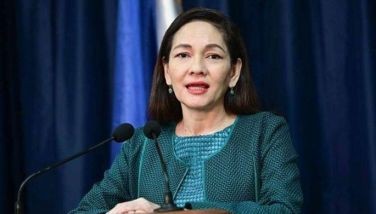Ex-Phivolcs chief’s death confirmed
May 17, 2005 | 12:00am
The forensic chemistry division of the National Bureau of Investigation (FCD-NBI) used the discovery of a right foot from the helicopter crash site to confirm that retired Philippine Institute of Seismology and Volcanology (Phivolcs) director Raymundo Punongbayan was one of the fatalities in the April 28 helicopter crash in Nueva Ecija.
After 18 days of DNA testing, FCD chief Idabel Pagulayan yesterday said they had completed their laboratory examinations and identified the seven other passengers of the ill-fated helicopter that crashed in the vicinity of Mt. Namat in Gabaldon, Nueva Ecija.
From the crash site, investigators recovered the remains of a right foot, which was subjected to DNA analysis. They cross-checked the DNA taken from the foot’s bone marrow and soft tissue to saliva samples taken from Punongbayan’s four children and found a match.
Punongbayan, 68, was a governor of the Philippine National Red Cross (PNRC) at the time of the accident.
Pagulayan identified the other fatalities as Orlando Abengoza and Dindo Javier of the Philvocs documentation section; Norman Tungol, Philvocs chief geologist; Jessie Daligdig, a scientist of the Department of Science and Technology (DOST); co-pilot Lt. Jason Salazar; and S/Sgt. Edgar Ramolete.
The nine passengers on board the Philippine Air Force (PAF) Huey UH-1H helicopter were on their way back from an aerial assessment of Dingalan, Aurora after assessing the renewed potential danger of landslides there. The helicopter crashed around 10:14 a.m. It is still unclear what caused the accident.
The NBI had previously identified the bodies of helicopter pilot Lt. Reynaldo Gerodias and Sgt. Whilbert Tacata because their bodies had been only slightly burned. Gerodias and Tacata were identified by their nametags.
"It is only now that we are able to confirm all their identities," Pagulayan said. "Now they can be turned over to their families for burial."
Since last month’s incident, the remains of the seven victims were kept at the Rizal Funeral Homes in Pasay City while the NBI worked to confirm its findings.
The FCD-NBI earlier estimated that it would take them a month to finish its report, but they completed the process in just three weeks.
NBI Director Reynaldo Wycoco said identifying the bodies of those burned beyond recognition in the crash "is a lengthy process," adding that the delay "is not the fault of the NBI but of limited technology."
Most of the fatalities’ body parts were burned beyond recognition and were retrieved by the PAF recovery teams that placed the remains inside 11 body bags.
Ramolete’s remains were distributed among four body bags, while Javier’s body parts were spread out among three bags and Daligdig’s mortal remains were placed in two body bags. The rest of the remains were compiled in one bag.
Pagulayan said it took them some time to verify which parts belonged to whom because they recovered 29 body parts and had 28 reference samples.
Among the body parts they found at the crash site were a knee joint and a lung.
The NBI took DNA swabs from the parents, spouses and children of other victims to help identify the remains. Human DNA can be extracted from hair, blood, bones, tissue and saliva.
After 18 days of DNA testing, FCD chief Idabel Pagulayan yesterday said they had completed their laboratory examinations and identified the seven other passengers of the ill-fated helicopter that crashed in the vicinity of Mt. Namat in Gabaldon, Nueva Ecija.
From the crash site, investigators recovered the remains of a right foot, which was subjected to DNA analysis. They cross-checked the DNA taken from the foot’s bone marrow and soft tissue to saliva samples taken from Punongbayan’s four children and found a match.
Punongbayan, 68, was a governor of the Philippine National Red Cross (PNRC) at the time of the accident.
Pagulayan identified the other fatalities as Orlando Abengoza and Dindo Javier of the Philvocs documentation section; Norman Tungol, Philvocs chief geologist; Jessie Daligdig, a scientist of the Department of Science and Technology (DOST); co-pilot Lt. Jason Salazar; and S/Sgt. Edgar Ramolete.
The nine passengers on board the Philippine Air Force (PAF) Huey UH-1H helicopter were on their way back from an aerial assessment of Dingalan, Aurora after assessing the renewed potential danger of landslides there. The helicopter crashed around 10:14 a.m. It is still unclear what caused the accident.
The NBI had previously identified the bodies of helicopter pilot Lt. Reynaldo Gerodias and Sgt. Whilbert Tacata because their bodies had been only slightly burned. Gerodias and Tacata were identified by their nametags.
"It is only now that we are able to confirm all their identities," Pagulayan said. "Now they can be turned over to their families for burial."
Since last month’s incident, the remains of the seven victims were kept at the Rizal Funeral Homes in Pasay City while the NBI worked to confirm its findings.
The FCD-NBI earlier estimated that it would take them a month to finish its report, but they completed the process in just three weeks.
NBI Director Reynaldo Wycoco said identifying the bodies of those burned beyond recognition in the crash "is a lengthy process," adding that the delay "is not the fault of the NBI but of limited technology."
Most of the fatalities’ body parts were burned beyond recognition and were retrieved by the PAF recovery teams that placed the remains inside 11 body bags.
Ramolete’s remains were distributed among four body bags, while Javier’s body parts were spread out among three bags and Daligdig’s mortal remains were placed in two body bags. The rest of the remains were compiled in one bag.
Pagulayan said it took them some time to verify which parts belonged to whom because they recovered 29 body parts and had 28 reference samples.
Among the body parts they found at the crash site were a knee joint and a lung.
The NBI took DNA swabs from the parents, spouses and children of other victims to help identify the remains. Human DNA can be extracted from hair, blood, bones, tissue and saliva.
BrandSpace Articles
<
>
- Latest
- Trending
Trending
Latest
Trending
Latest
Recommended





























